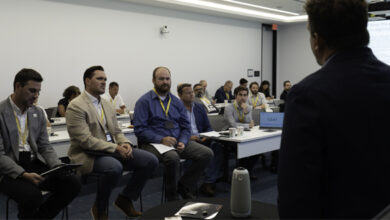Industry/academia collaboration results in rapid development of intelligent, self-learning drilling app
NOVOS system allows UT grad students to easily incorporate complex algorithms into automation application
By Claire Kennedy Platt, National Oilwell Varco, and Eric Van Oort, University of Texas at Austin

Operators’ increasing demand for consistency with predictability and risk avoidance is enhancing the drilling industry’s need to automate. Continuous academic research can help the industry to meet this challenge, but presenting graduate-level research into the field can be difficult for universities, as finding an operator willing to implement an idea can take as long as five to six years. To shorten this process, collaboration within the industry will be required.
This collaboration is now happening between National Oilwell Varco (NOV) and the University of Texas at Austin (UT). Relying on the straightforwardness of NOV’s NOVOS reflexive drilling system, petroleum engineering graduate students at UT have been able to complete – within months – a application that is ready for field trials.
Tools that have enabled this achievement include the NOVOS software development kit (SDK), which guides software developers through the process of creating an application that lives on the platform. The SDK provides clear-cut development language so that students can write applications based on their research and technical knowledge of the science behind drilling, even without a computer science background. This provides the industry with the ability to more easily build customized applications for drilling operations and serves as a pathway for research to enter the market.
University collaboration
Rig Automation and Performance Improvement in Drilling (RAPID) is a multidisciplinary industry affiliate program housed at UT. Through this program, the UT drilling automation research team is developing field-applicable technology with the goal of making such technology available to program partners, operators and the industry. While operators support and sponsor the work at RAPID, the research team also needs facilitation to bring their technologies to the field.
NOV, a founding industry member of RAPID, provides this facilitation with widely deployed, automation-ready drilling systems. NOV handles the safety aspect of the collaboration, which enhances operators’ willingness to try the apps. In turn, this allows the university to showcase new automation developments to operators immediately. This reduces the amount of time required for industry to adopt technical advances resulting from university research.
Drilling automation research team members from UT are presenting on this topic at the 2018 IADC Advanced Rig Technology Conference in September. The presentation cites benefits of the openness of NOVOS and the advantages of enabling graduate students to build apps that are ready to be deployed and to quickly present research into the field.
University research
Following the introduction of NOVOS, UT applied for an SDK license and worked with NOV to learn more about the platform. The research team then began writing code for the platform to manage weight-on-bit (WOB) and RPM, resulting in an advanced, intelligent autodriller app with self-learning capabilities.
The team determined how to integrate a third-party library and have completed theoretical studies and simulations for an improved autodriller application. Now, attention has turned to commercialization, and the team is seeking options to test the application. The goal is to deploy the intelligent autodriller on a working rig within the next year.
This work is also contributing to UT RAPID’s long-term goal of creating a closed-loop control system on the PLC level. The research team is leveraging the simulation capabilities of the NOVOS platform to improve its algorithms in a controlled environment.
Shaping future leaders
As oil and gas companies focus on production maximization and efficiency, industry requirements for engineers have shifted. The industry’s increasing reliance on automated processes and data has led to an increasing demand for workers with experience in data analytics and programming. To accommodate this change, UT is adjusting its curricula and embracing NOVOS as a tool to teach its students in a different way.
Students, too, have embraced the opportunity to gain valuable experience by creating applications for the drilling platform, which raises their interest in pursuing oil and gas careers. Further, students are recognizing that this experience with programming and automation increase their marketability to potential employers. Adding NOVOS to the curriculum has increased students’ understanding of drilling processes and enabled them to perform better data analyses.
Currently, UT’s program caters primarily to graduate students. However, faculty sees the potential to involve undergraduate students in the future.
NOVOS capabilities

To date, more than two dozen companies have developed apps through NOVOS, and multiple rigs are actively using the system to drill in Texas, Oklahoma, Pennsylvania, the Alaskan North Slope and Canada. It has assisted operators in drilling more than 2 million ft of wellbore.
NOVOS software enables automation of repetitive drilling activities, allowing drillers to focus on consistent process execution and safety. The scalable system can be expanded to full closed-loop automation. An imported well plan describes desired drilling parameter ranges, enabling the system to optimize the performance within the given set of parameters based on the well plan. Users can set parameters to meet requirements, including circulation and WOB.
Conclusion
By enabling simple and efficient app creation and field implementation, NOVOS allows users to quickly create automated solutions to solve drilling challenges. UT and the oil and gas industry reap mutual benefits as sponsors fund research that can be supported in the field, bridging the divide between academic research and practical use and reducing implementation and adoption time.
The ease of implementing sophisticated software code into NOVOS presents additional opportunities for future applications. UT is currently handling industry requests on a project-to-project basis, with a focus on automating solutions for safety and operational efficiency. The drilling automation research team is considering options for automated event detection and anticipates that using university control algorithms and research through the drilling platform could help research on automated managed pressure drilling (MPD) control find a route to market.
To date, several operators have taken out licenses for NOVOS, and drilling rigs equipped with the system are executing automated well plans. UT also anticipates an increase in requests from operators for specific applications for the system. DC
NOVOS is a trademark of National Oilwell Varco.
This article is based on a presentation at the 2018 IADC Advanced Rig Technology Conference, 11-12 September, Austin, Texas.




